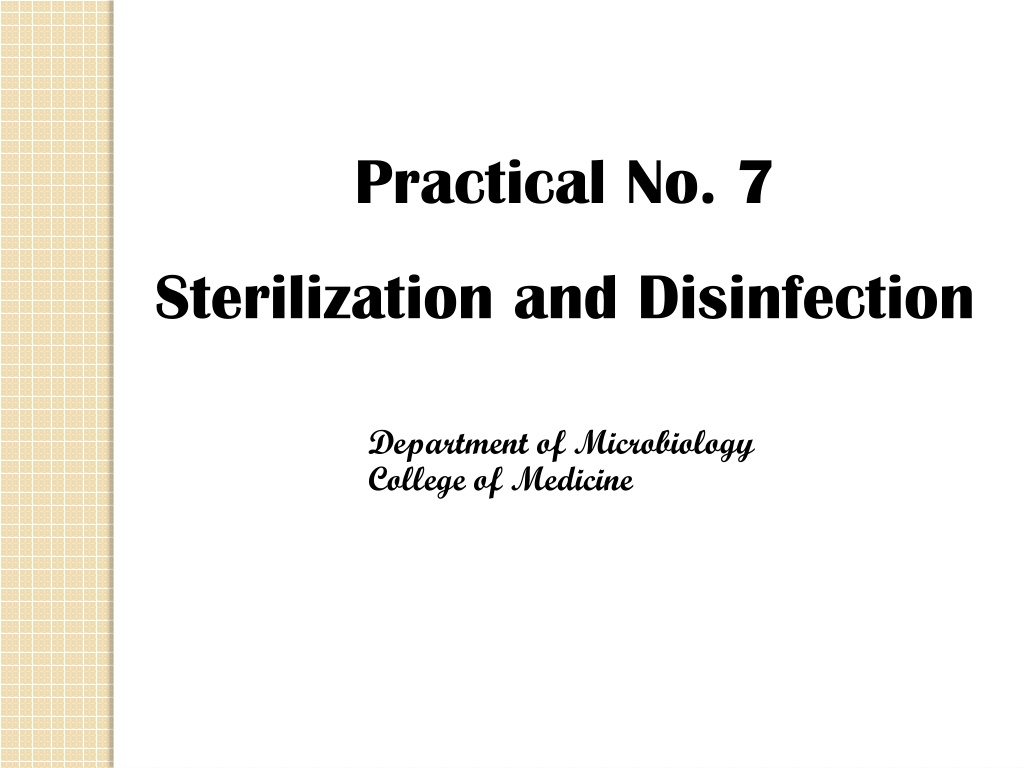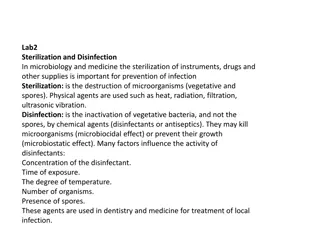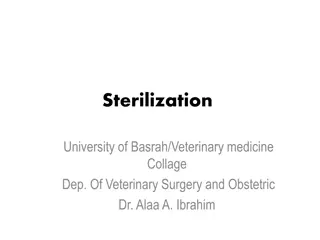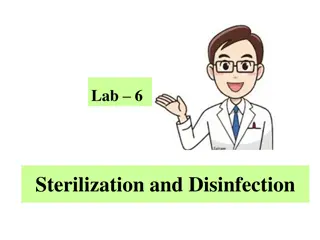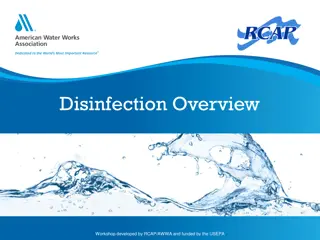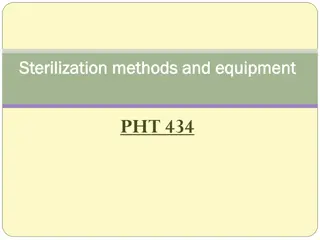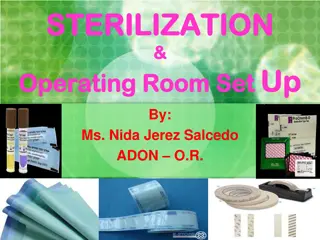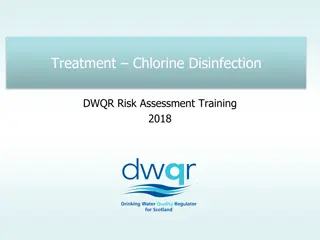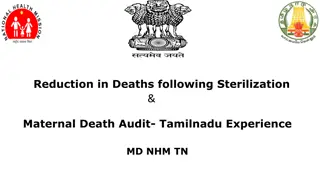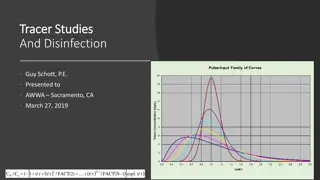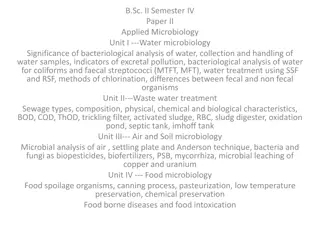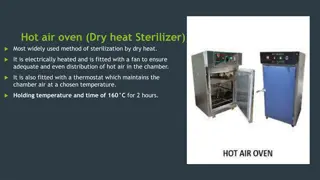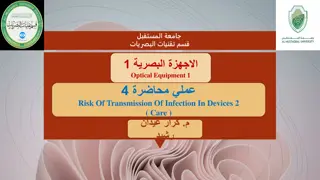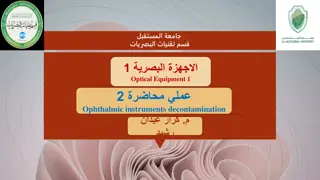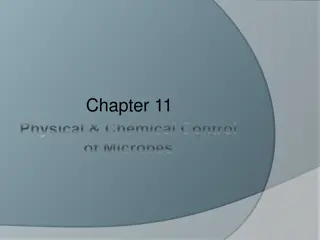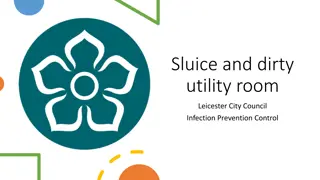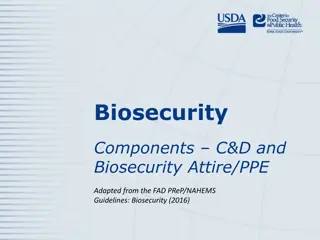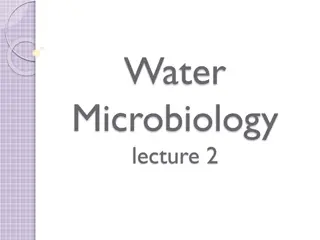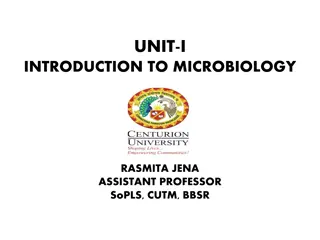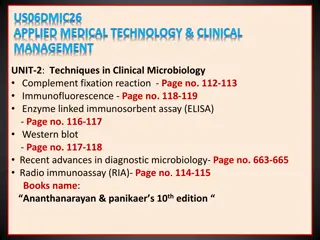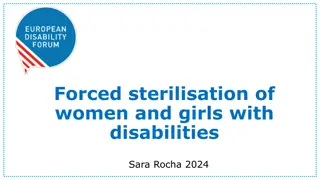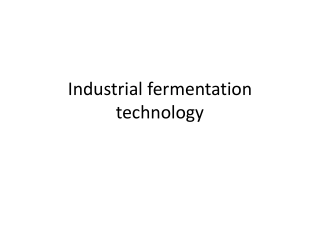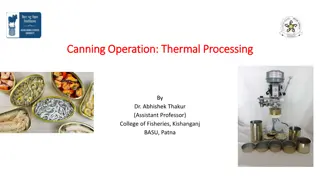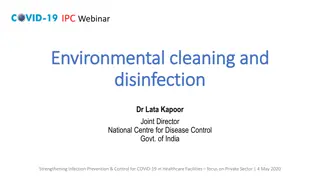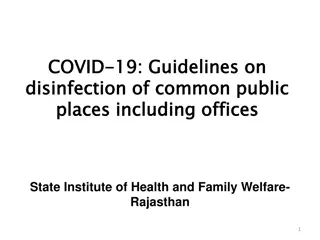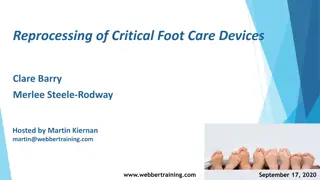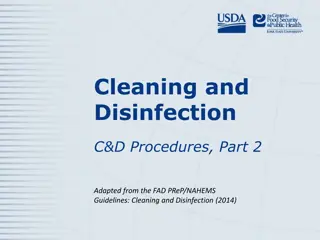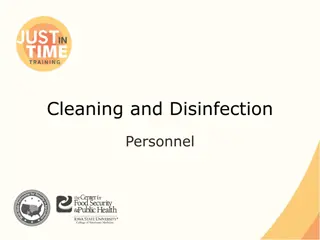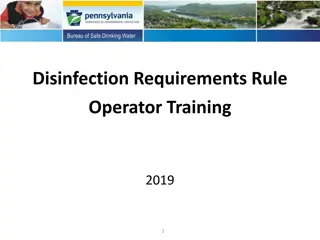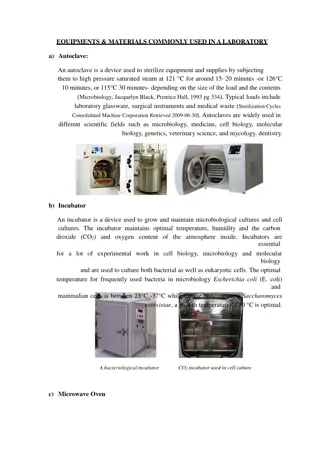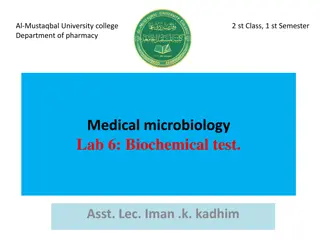Sterilization and Disinfection Methods in Microbiology
Sterilization and disinfection are crucial processes in microbiology to eliminate all microorganisms and prevent their spread. Methods such as heat, ethylene oxide gas, and filtration are employed to achieve sterilization. Physical agents like heat through dry heat, flaming, and hot air ovens, as well as chemical agents, are commonly used for sterilization. Moist heat methods like pasteurization and boiling water are effective for killing various organisms. Tyndallization and steam under pressure in an autoclave are also used for sterilization of instruments and glassware in microbiology labs.
Download Presentation

Please find below an Image/Link to download the presentation.
The content on the website is provided AS IS for your information and personal use only. It may not be sold, licensed, or shared on other websites without obtaining consent from the author. Download presentation by click this link. If you encounter any issues during the download, it is possible that the publisher has removed the file from their server.
E N D
Presentation Transcript
Practical No. 7 Sterilization and Disinfection Department of Microbiology College of Medicine
Sterilization: Is the killing or removal of all micro-organisims, including bacterial spores, which are highly resistant. e.g.: - Sterilization by autoclave (121oc , 15Klb). - Ethyl oxide gas for surgical instruments. - Filtration for intravenous solution. Classification of sterilization agents: 1- Physical agents: a- heat 2- Chemical agents: b- filtration c- radiation
1- Physical agents: A- Heat: Most effective cause it effectively stops cellular activates by coagulate proteins or oxidize cell components. Types of sterilization by heat: Dry heat Red heat Red heat ( Direct flame): for rapid and repeated sterilization e.g.: Loop, Forceps by using Bunzen burner. Hot air: By using oven. e.g.: glass ware, metal instrument (left in a hot air oven on a temperature of 160- 180oc for one hour). Incineration: by using electrically heated or gas- fired incineration filled with forced air blower units. e.g.: solid dressings, pathological material, animal caresses and bedding.
Flaming Flaming
- -Hot air oven Hot air oven: : Temperature of 160 C for 1 hour is employed. Hot air oven is the best method for sterilizing dry glassware, forceps, scalpels...other steel & dental &surgical instruments, powders, fat, greases. Hot air Hot air oven oven
Glassware Glassware
Moist heat : - Pasteurization: Use 63oc at 30 minutes. Milk born- disease are killed by this process. e.g.: Brucella, Salmonella, and tubercle. Sporing Bacteria are not killed. - Boiling water: A temperature at 100oc will kill all non- sporing or vegetative organism within 10 minutes. Most spore will be killed in 30minutes in this temperature, but some spores will resist boiling for several hours. 2% of sodium carbonate increase the disinfecting power of the water.
This method is suitable for infected instruments or small pieces of infected glassware: -Tyndallization: Sterilization by intermittent steaming. - Steam under pressure: The steam is placed under pressure in an autoclave. Bacteriological media, surgical instruments are sterilized in the auto clave at 121oc (15 Ibs) for 15 minutes.
c c- - At a temperature above At a temperature above 100 increased pressure this is called (Autoclaving is the usual method of sterilizing bacteriological media, surgical instruments, towels, dressing, gloves,..etc The minimum values required for sterilization in an efficient autoclave are 15 lb/inch2 121 C 15 minutes. 100 C: C: steam under Autoclaving). This Surgical dress Surgical dress
Surgical instruments Surgical instruments
Autoclave Autoclave
B- Filtration: The material must pass through special bacterial filters which hold back any bacteria present. e.g.: Sera, Plasma, Vitamins and antibiotic solutions. Filters are made of unglazed porcelain, mandler . C- Radiation: Sterilization of large amount of pre-packed disposable items. By Ultra violet rays. e.g.: Plastic syringes and Catheters
FOLEY CATHETER: STERILIZED BY IONIZING RADIATION
FILTRATION FILTRATION To render fluids, including bacterial culture, free from bacteria by passing them through special filters, e.g Seitz filter Seitz filter. This method is used in sterilizing liquids that would be damaged by heat such as serum, vaccines, antibiotic solutions, sugars, toxins, etc.
Experiment: Materials Provided: 1-Nutrient Broth (4 tubes to each group) 2-Sterile forceps 3-Sterile paper strips 4-Broth culture of E. coli and B. subtilis
Procedure: a- Contaminate 4 strips by dipping them into one of the cultures supplied. b- Place one strip in a broth bottle, labeled ''Control''. c- Place a second strip into a broth bottle and hold in boiling water bath for 15 min. d- Place a third strip into a broth bottle and autoclave at 15 atm. pressure for 15 minutes. e- Place the fourth strip into 70% alcohol, leave for 15 minutes shake off the alcohol and drop the strip into a broth bottle. f- Label all bottles (or tubes) with organism and treatment. g- Incubate them at 37 for overnight. h- Record the results.
2- Chemical Agents: Alchohols, Ethyl alcohol, Isopropyl alcohol (70%): Antiseptic to sterilize thermometer and skin before injection. Phenols: Sterilization of surgical instruments, bathroom, hospital floor. Heavy Metal Ions: (Metallis salt), (Mercury; Silver nitrate). Use as preservation for sera or viral vaccine. Oxidizing agent: H2O2 for contaminated wound Halogens : Chlorine and hypo chlorite to disinfect the swimming pools and water supplies.
STERILIZATION Chlorhexidine Chlorhexidine agents agents
* Iodine Iodine (Betadine): used in surgery to sterileize skin pre-operation
Akalyting Agents: Formaldehyde: for instruments, Lab, and Clothing, books Ethylene oxide: for heat sensitive objects plastic petri dishes, tubs, syringes . Detergents: Soaps, quaternary compounds
Experiment: Materials Provided: Tubes of nutrient broth Sterile, empty tubes Sterile, 10-ml pipettes (cotton plugged) Sterile, 1.0-ml pipettes (cotton plugged) 1.0 per cent phenol, 2.0 per cent phenol Absolute alcohol, 70 per cent alcohol 3.0 per cent hydrogen peroxide 1.0 per cent Lysol, 5 per cent Lysol Tincture of iodine Antiseptic mouthwash 24-hour nutrient broth culture of Escherichia coli Three-to-six-day-old culture of Bacillus subtilis
Procedures: 1- Select one of the chemical agents. Draw 5.0ml of the solution into a sterile test tube. 2- To the 5ml of disinfectant, add 0.5ml of the E. coli culture. Gently shake the tube to distribute the organisms uniformly. Note the time. 3- At intervals of 2, 5, and 10 minutes, transfer one loop full of the disinfectant-culture mixture to a tube of fresh nutrient broth. Label each broth tube with the name of the organism, the disinfectant, its concentration, and the time of exposure (for example, E. coli, 1 percent phenol, 2 minutes). 4- Using the same concentration of the same disinfectant, repeat procedures 1 to 3 with the culture of B. subtilis. 5- Inoculate a tube of nutrient broth directly from the E. coli culture and another from the B. subtilis culture. Label each tube with the name of the organism and the word ''Control''. 6- Incubate all tubes at 35 for 48 hours. 7- Record your results.
Thank You Thank You
